Elementary Psychology exam 1 : UIOWA
1/99
There's no tags or description
Looks like no tags are added yet.
Name | Mastery | Learn | Test | Matching | Spaced |
|---|
No study sessions yet.
100 Terms
___ degrees of separation
- shortest connection between you and someone else
- can find a path between 2 people
- roughly 3.6 degrees between you and someone else
- 8 degrees of separation between you and Wilhelm Wundt
6 basic emotions
anger, disgust, fear, happiness, sadness, and surprise
Carl E. Seashore
-worked at the University of Iowa
-MUSIC PSYCHOLOGY
-dean of liberal arts and sciences (LIB)
-focus on development of those who are truly talented
Wilhelm Wundt
- known as father of psychology
- developed introspection (SELF REFLECTION look inside) which LEAD TO structuralism
- Found time lag between hearing sound and signaling they heard it / describe whats going when played
- wanted to measure "atoms of the mind", structure of mental processes
Edward Boring's proposal
psychology rests on two pillars:
- philosophy
- physiology
2 Pillars of Psychology (foundations of psychology)
- proposed by professor Boring:
(1) PHILOSOPHY:
-->Socrates, Hume, Locke, Aristotle
-->Nature (born with) v. Nurture (environment)
(2)PHYSIOLOGY:
-->Helmhota, Darwin, Muller
-->NEURAL COMMUNICATION: can be measured, suggesting mental processes might be measured
Structuralism
- The "what"
emerged from introspection***
- understand complex Structure of human mind & break them down
-"tell me what you're experiencing"
-not many agree with idea
- early school of thought promoted by Wundt & Titchner
Functionalism
Key ? = How do thoughts naturally flow and change w enviro?... stream of consciousness
-more than just tiny parts
-****opposed structuralism (not continuously the same)
WON IN END
---> by James & influenced by Darwin;
- how mental & behavioral processes work to adapt, survive, & flourish
Behaviorism
-reaction against introspection
-only study observable behavior; hidden mental processes should not be studied
-Ivan Pavlov, John Watson, B.F Skinner
-can be observed multiple times over
Computational Theory of Mind
-why we think the way we do
-longterm memory v. short term
Cognitive Revolution
-we all have thoughts that are not observable
-psychology can study hidden mental processes such as memory, attention, stereotypes, beliefs, etc.
-mind is like a computer
computational theory of mind``
Reactions to Freud
(1950's) -- this all influenced where we are today
-Freud believed that all behavior is caused by inner conflict
-THE PROBLEM: over looks problems of what causes a person to feel _______ = HUMANISTIC PSYCHOLOGY (emphasizes with patient without Freud's viewpoint)
Sigmund Freud
all about the UNCONSCIOUS and that it is DARKKK
-all details of his ideas probably wrong
-there are hidden influences behind our behavior
- DREAM INTERPRETATION
-it is true that the unconscious does influence behavior but it's limited!
Correlational Research
-examine how 2 or more variables interact with each other
-naturally occurring behaviors
Experimental Research
-researcher manipulates 1 variable & measures effects of the manipulation on another
- random assignment
3rd variable
-will effect both; Z (third variable) will effect both X & Y
Theory
-supported by an operational definition
---> FROM THE BOOK: an explanation using an integrated see of principles that organizes observations and predicts behaviors or events
Operational Definition
-a way to measure what you want to measure
---> FROM THE BOOK: a carefully worded statement of the exact procedures/operations used in a research study [IE: human intelligence may be operationally defined as what an intelligence test measures
Hypothesis
-statement/prediction we can systematically test
--->FROM THE BOOK: a testable prediction, often implied by a theory
Independent Variables (IV)
-manipulated by expire expirementor (control v. experimental group)
--->FROM THE BOOK: in an experiment, the factor that is manipulated; the variable whose effect is being studied
Dependent Variables (DV)
-measured
---> FROM THE BOOK: in an experiment, the outcome that is measured; the variable that may change when the independent variable is manipulated
Confederate
a person who is given a role to play in a study so that the social context can be manipulated
external validity
the extent to which the results of a study can be generalized to other situations and to other people REAL WORLD ISSUES
internal validity
extent to which we can draw cause-and-effect inferences from a study
Bias
-systematically affects participant performance
Demand Characteristics
-cues that reveal what the experimenters expectations of the participants are to them
Placebo Effects
-reason fro double-line studies [neither the participants nor those who administer the drug or placebo and collect the data will know which group is receiving treatment]
---> FROM THE BOOK: experimental results caused by expectations alone; any effect on behavior caused by the administration of an inert substance or condition, which the recipient issues is an active agent {well documented in reducing pain, depression, and anxiety}
Psychokinesis
-the ability to affect physical objects with the mind
Psi Phenomena
-a broad term for both extrasensory perception (ESP) & psychokinesis, the ability to affect physical objects with the mind
-Why is this not justifiable?
---> it does not replicate (not verifiable)
---> no structure
ESP or Extrasensory Perception
- 6th sense
the controversial claim that perception can occur apart from sensory input; includes telepathy, clairvoyance, and precognition
Characteristics of Science
(1) Structured Empiricism (empiricism = observation)
(2) Verification: peer review (replication= likely to be VALID results)
(3)testable hypothesis
Cautionary Points {guidelines for critical thinking}
1. Anecdotes do not make a Science
2. Bold claims aren't necessarily true
3. Just because something is unexplained doesn't mean that an explanation doesn't exist
4. Coincidence ("synchronicity")
5. Don't appeal to authority only
6. explore alternative explanations
Einstein's Brain
-parietal lobe used for location making
Thomas Hardy
-he fixed & sectioned Einstein's brains so he could study it after getting consent from his family [Einstein originally asked for this not to occur]
-brain missing for 2 decades
-gave tissue samples to labs & some studies show what makes us smart like Einstein.
What are the 3 main divisions of the brain?
1.) hindbrain
2.) midbrain
3.) forebrain
Hindbrain
-lowest set of structures in the brain
-Vecera says: think of it as your reptilian brain because many of the structures do the same thing in humans that they do in reptiles
Houses:
1. Medulla
2. cerebellum
3. pons
Medulla
beings where spine enters skull
- breathe, HR, reflexes
Cerebellum
A large structure of the hindbrain that controls fine motor skills.
Pons
A brain structure that relays information from the cerebellum to the rest of the brain - brain stem
--- sleep and arousal
brain stem
Connection to spinal cord.
--- all of hindbrain except cerebellum
Filters information flow between peripheral nervous system and the rest of the brain.
- alertness, HR, BP, breath, basics
Midbrain
- information from brain, eyes, ears
1. reticular formation
-----"sterotype behaivor patterns" turning to noise, sleeping at night
2. system using neurons and neurotransmitters
-our bird and amphibian brain because its similar in humans and amphibians
Forebrain
Largest region of brain
1. limbic system
2. thalamus
3. basal ganglia
4. hypothalamus
5. cerebral cortex
Thalamus
- the brain's sensory switchboard,
- located on top of the brainstem
- RELAY STATION - directs messages to the sensory receiving areas in the cortex and transmits replies to the cerebellum and medulla
Basal Ganglia
- clusters of ganglia (neurons) working with cerebral cortex to control/ coordinate normal movements (FINE/small MOVEMENTs like texting)
--> parkinson's disease, degenerative disease; resting TREMORS;
movement =stooped; hard time initiating / executing voluntary movement [can be genetic or caused from trauma to the head]
Limbic System
located below both the left & right cerebral hemispheres; associated with emotions and drives
contains:
---amygdala (almond shape on each side of brain...survival; what is edible, intense emotional awareness),
----hippocampus (determines which parts of the memory should be stored/printed)
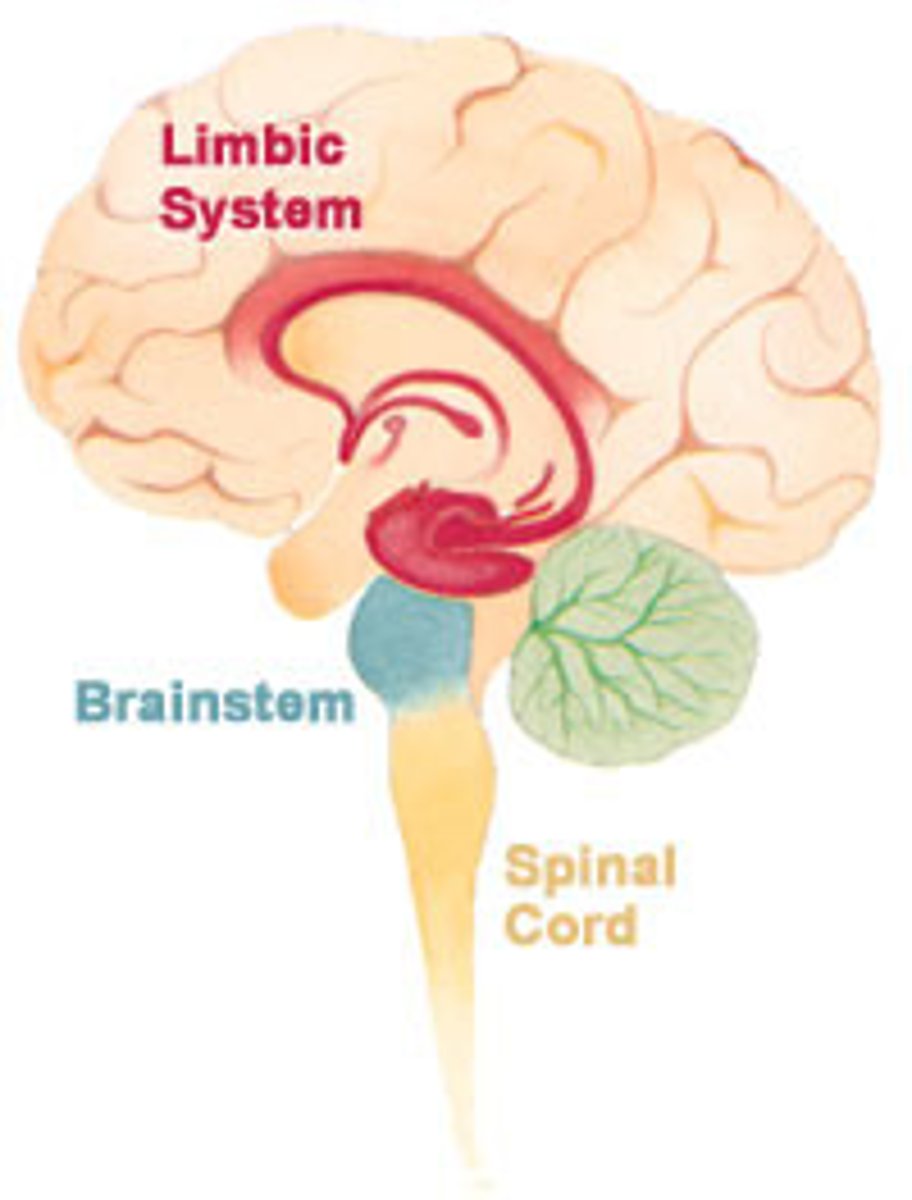
Cerebral Cortex
- outer/ what you see, newest part of brain
- divided into lobes and L&R hemispheres
- wrinkled so it fits into a small space - -incr S/A
- its our "gray matter"
---> the intricate fabric of interconnected neural cells covering the cerebral hemispheres;
---->the bod's ultimate control and information-processing center
Neuropsychology of Cortex
-MAIN IDEA: psychological behaviors can be localized--pinpointed to--different regions of the cortex [but do not oversimplify localization of function because complex behaviors require many areas working together]
Localization of function
different regions of the cortex responsible for different psychological behaviors
Hypothalamus
- a neural structure lying below (hypo) the thalamus
- directs several maintenance/pleasure activities (eating, drinking, SEX, body temperature),
- helps govern the endocrine system via the pituitary gland, and is linked to emotion and reward
--- 4 Fs (feed, fluid intake, fighting, f***ing )
Hippocampus
-LEARNING {new things} & MEMORY {amnesia}
-IE: patient H.M; severe epilepsy, bilateral removed lots of tissue, no epilepsy but extremely amnesic & changed personality [he kept his long term memory but didn't know he was aging]
---> FROM THE BOOK: a neural center located in the limbic system; helps process explicit memories for storage
Amygdala
-EMOTION (especially fear)
-people with problems here lack fear--they cannot read it off of faces either
-keeps us safe
---> FROM THE BOOK: two lima-bean-sized neural clusters in the limbic system; linked to emotions
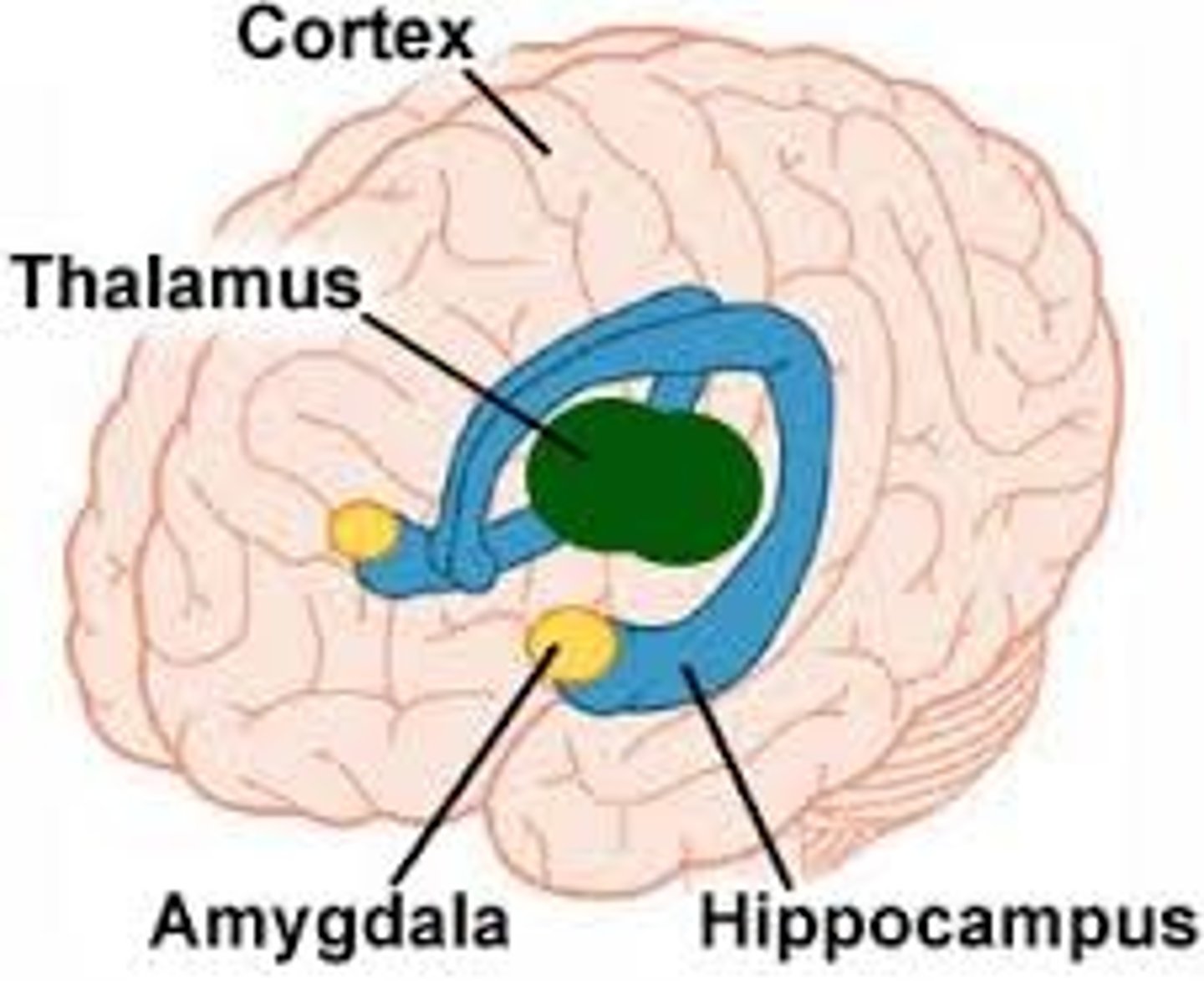
Occipital Lobe
-exclusively devoted to vision & visual perception {colorblindness, cortical blindness, humans devoted to vision}
holds :"visual cortex"
--->back of the head; areas that receive information from the visual fields
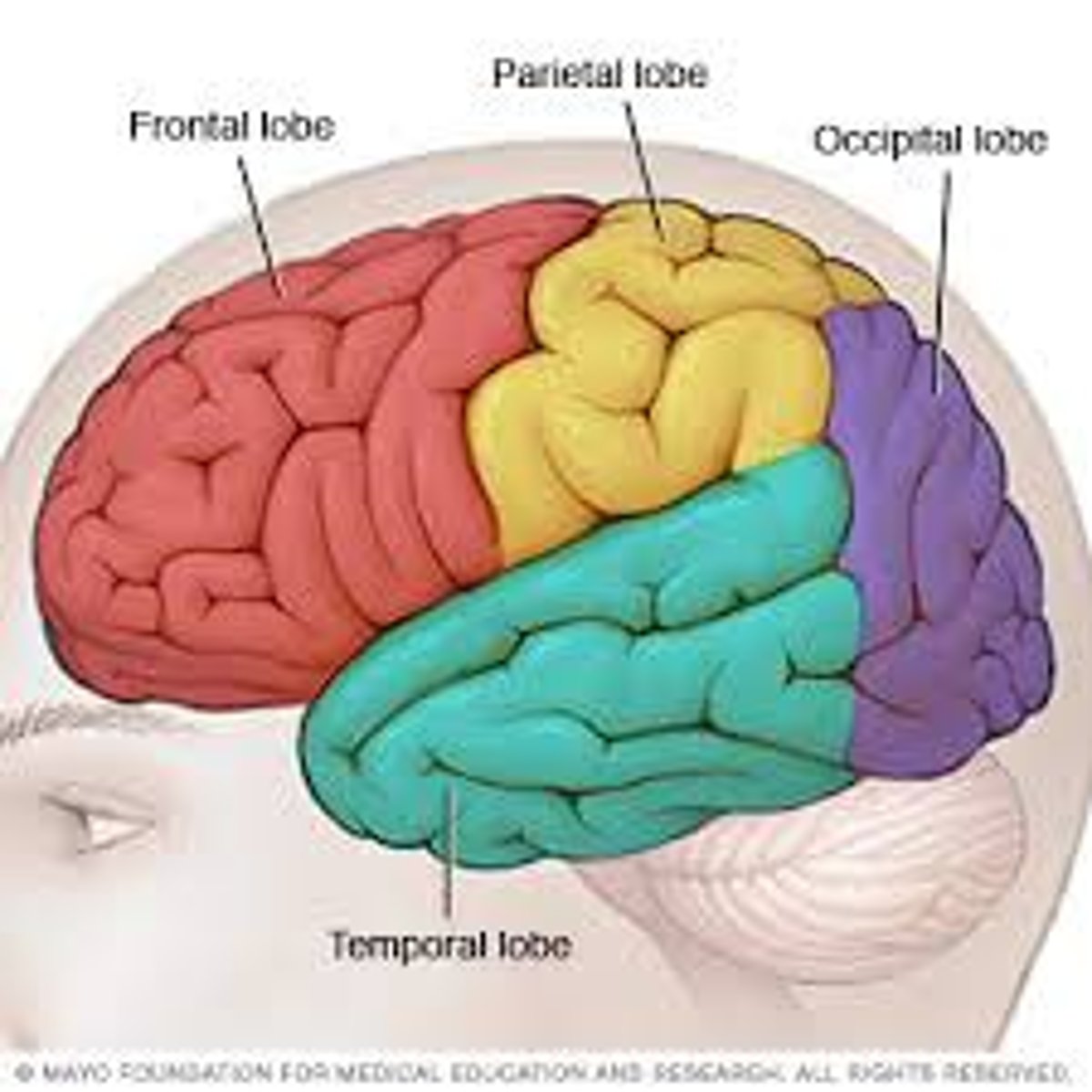
Parietal Lobe
involved in
_ perception of touch {body sensation}
_ spatial location {layout of world around us}
_ motor control ... how far to throw ball to reach player
--->top of the head and toward the rear;
- receives sensory input for touch and body perception
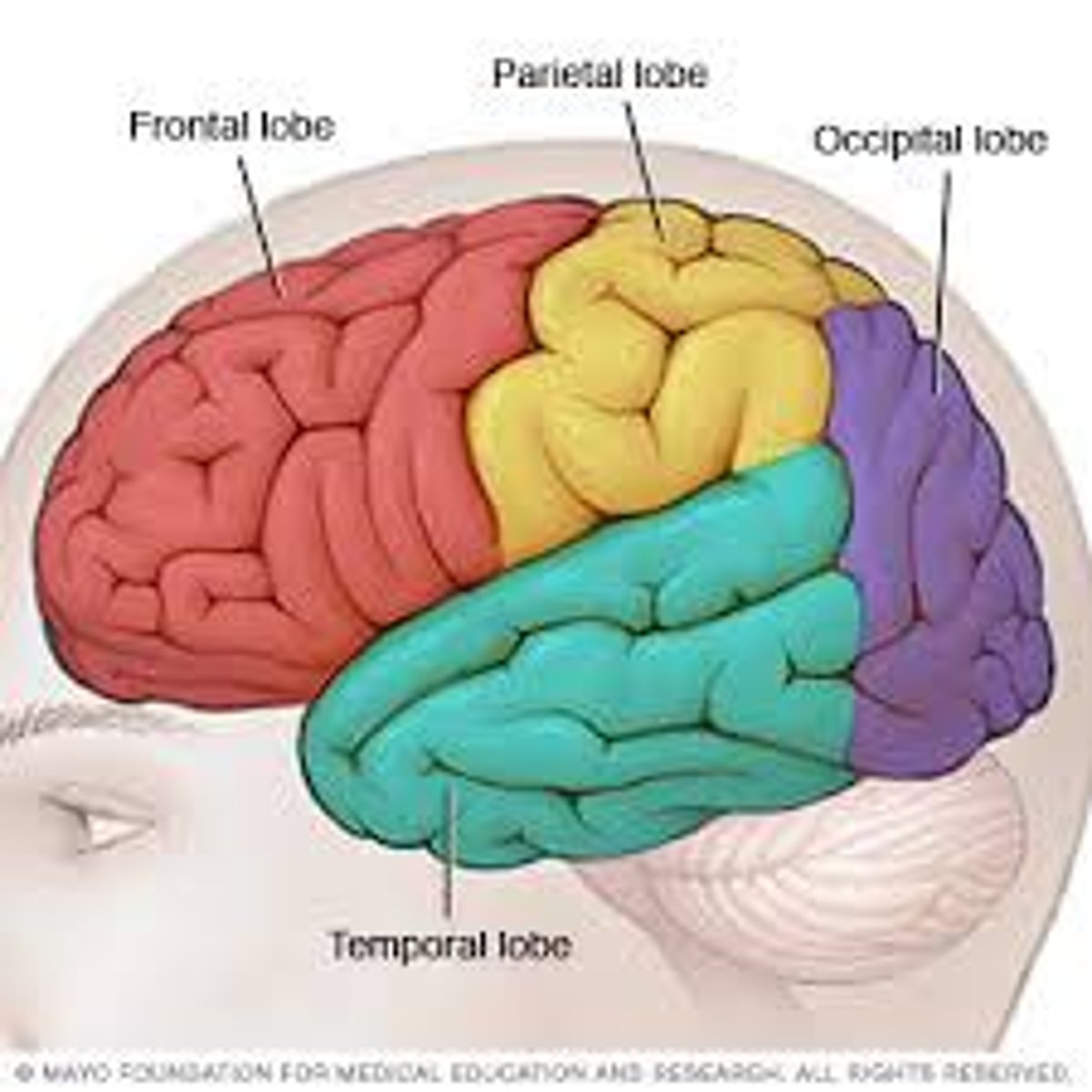
Temporal Lobe
-involved in
(1) perception of objects {visual}, MEMORY
(2) auditory perception {hearing}
(3) language comprehension
-following______ lobe damage, patients have poor long term memory
-WERNICKE'S AREA: speech understanding
---> roughly above the ears; includes the auditory areas, each receiving information primary from the opposite ear
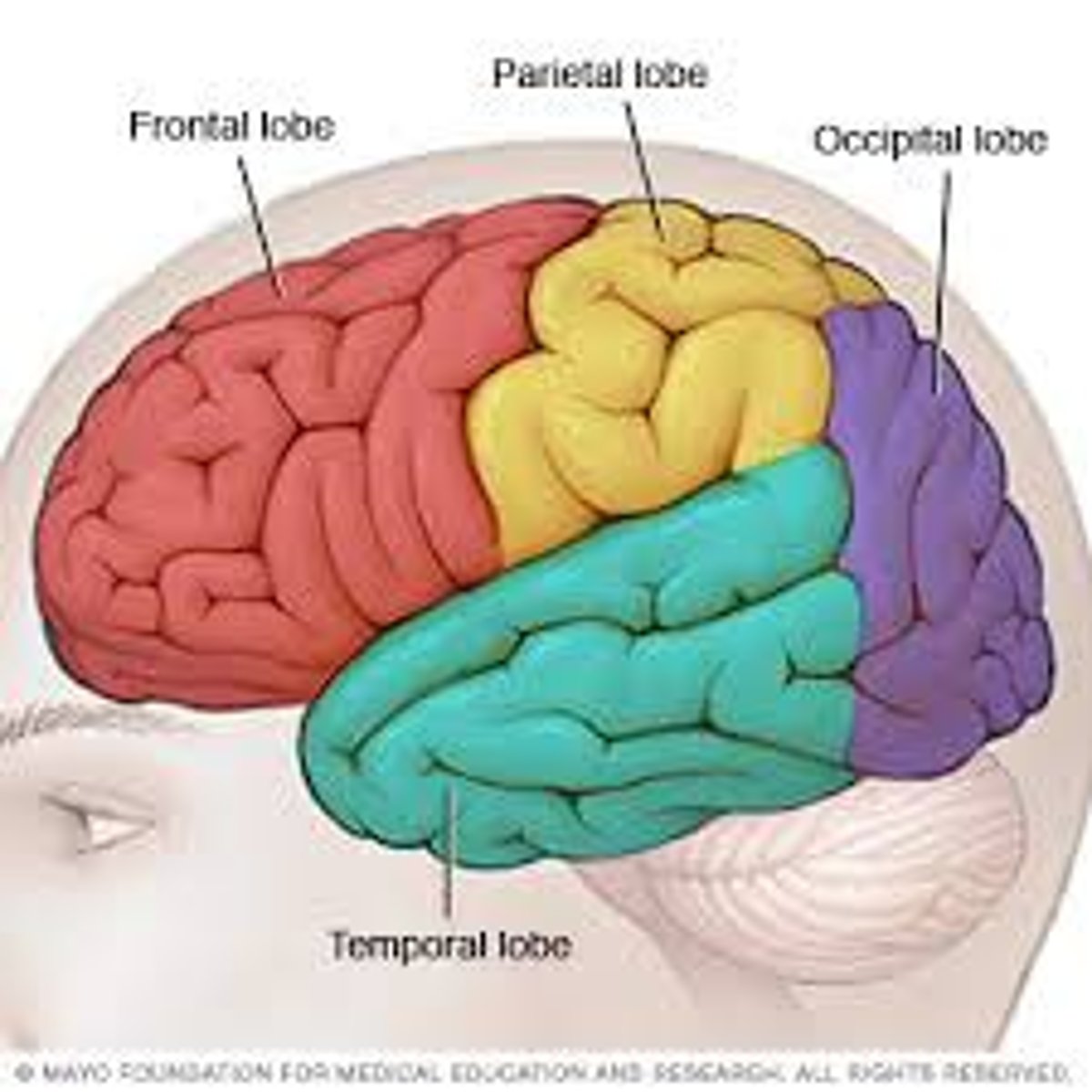
Frontal Lobe
PERSONALITY
-involved in
(1) speech production
(2) movement {especially voluntary}
(3) complex thinking (pre frontal cortex)
(4) regular behavior
---> behind the forehead; involved in speaking and muscle movements in making plans and judgements
PHINEOUS GAGE == drill to head, completely different person (mean)
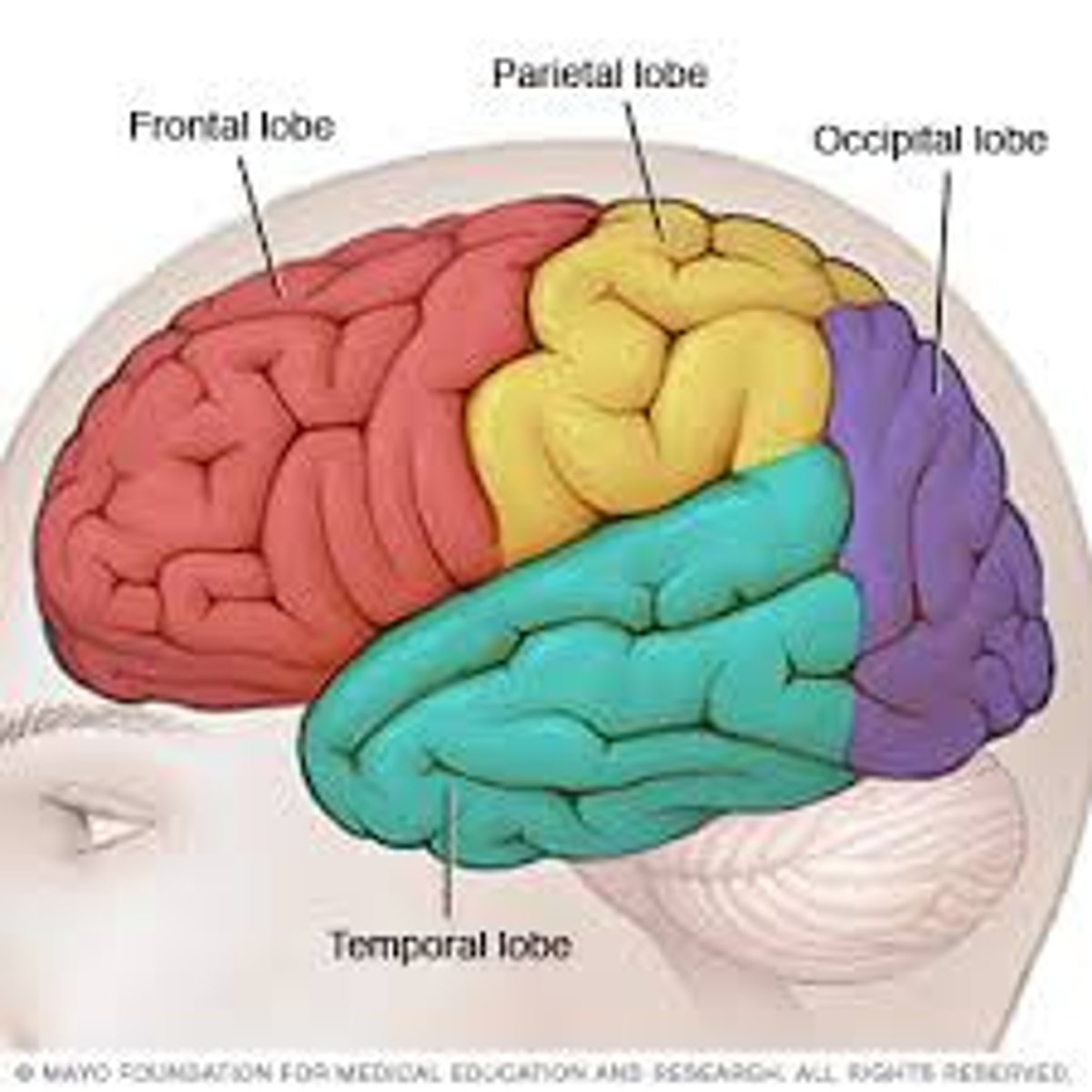
samatosensory cortex
found: front of parietal lobes
processes information about body sensations
motor cortex
behind frontal lobe
- info about voluntary movement
association cortex
75% of the cerebral cortex .. highest intellectual functions, integrate simpler functions to perform more complex functions (sensory and motor)
damage only hurts language area... largest portion is in frontal lobe under forehead (loss of execute function..planning)
optic chiasm
the point in the brain where the visual field information from each eye "crosses over" / divide to the appropriate side of the brain for processing
Agnosia
-impairment in object recognition
-cannot recognize objects {will try and guess if they can; some lose ability to recognize faces}
Aphasia
-impairment in language
-language difficulties
Amnesia
-impairment in memory
Phineas Gage
-frontal lobe = most damage
-donated body to science (Iowa had research time)
-what happened after? [optic nerve severed / entire personality changed / made bad choices / could not regulate behavior]
![<p>-frontal lobe = most damage</p><p>-donated body to science (Iowa had research time)</p><p>-what happened after? [optic nerve severed / entire personality changed / made bad choices / could not regulate behavior]</p>](https://knowt-user-attachments.s3.amazonaws.com/7965acfc-4bc9-45de-ae6c-97ed752cf636.jpg)
Somatosensory Homunculus
-ordered map of skin surface in parietal cortex
(1) adjacent points remain adjacent {same cells respond to the same fingers on each hand}
(2) some regions have more cortex devoted to them
Neurons
-billons of them; building blocks of the brain
- limited reproduction, sensitive
"neurons that fire together, wire together"
---> FROM THE BOOK: a nerve cell; the basic building block of the nervous system
Glial Cells
-supported cells = clean waste / provide nutrients /
---> FROM THE BOOK: cells in the nervous system that support, nourish, and protect neurons; they may also play a role in learning, thinking, and memory
- reproduce through lifespan
Dendrites
---> FROM THE BOOK: a neuron's often bushy, branching extensions that receive messages and conduct impulses toward the cell body
Anatomy of a Neuron
-dendrites
-axon
-axon hillock
-myelin sheath
-axon terminal
-synapse
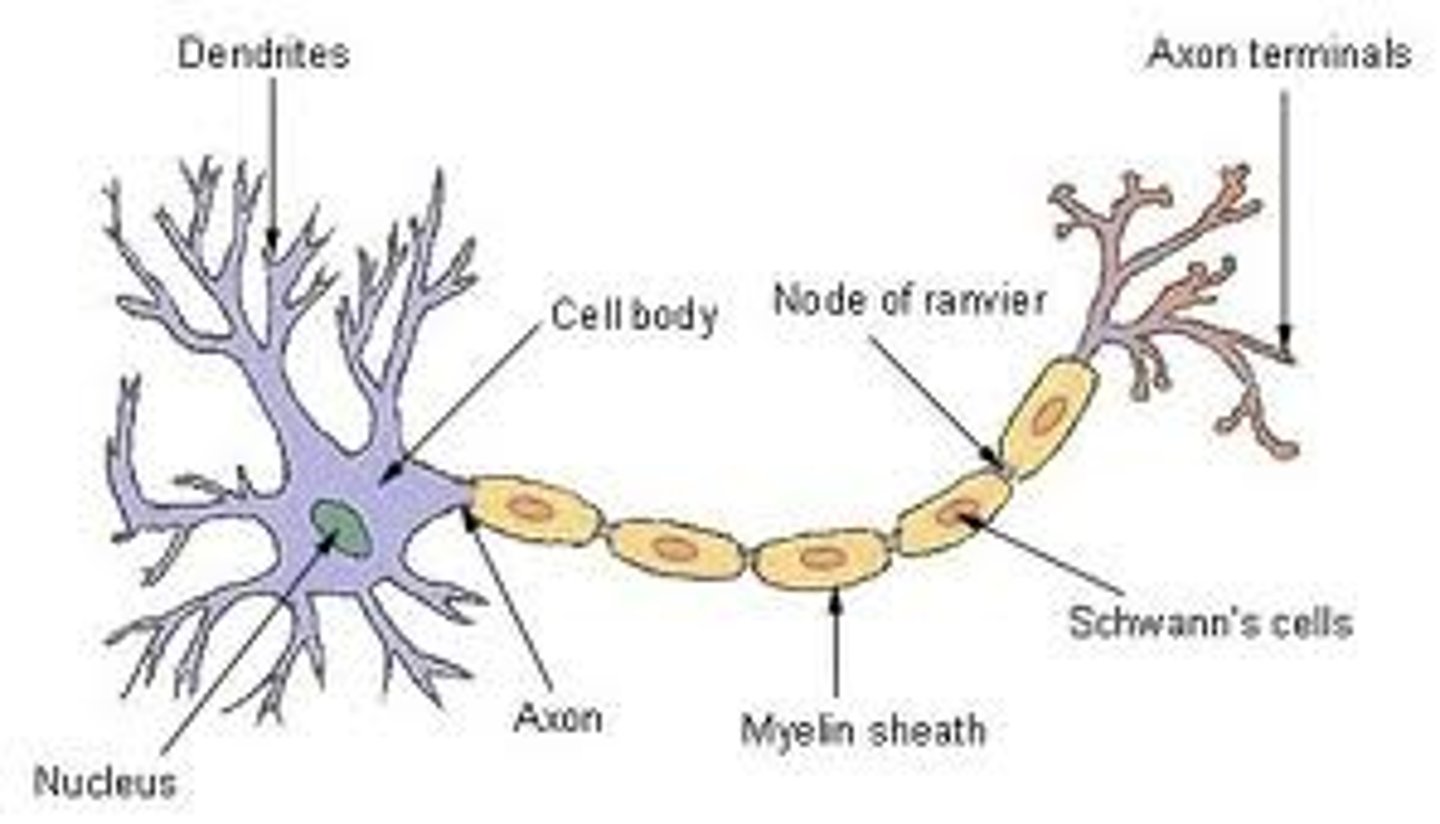
Axon
---> FROM THE BOOK: the neuron extension that passes messages through its branches to other neurons or to muscles or glands
Axon Hillock
-specialized region of the cell body near the body of the axon
Myelin Sheath
-fatty tissue insulating axon; increases speed of neural transmission
-Loss of myelin results in multiple sclerosis
---> FROM THE BOOK: a fatty tissue layer segmentally encasing the axons of some neurons; enables vastly greater transmission speed as neural impulse hop from one node to the next
cell body (soma)
contains the nucleus and other parts of the cell needed to sustain its life
Synapse
-space between 2 neuron
---> FROM THE BOOK: the junction between the axon tip of the sending neuron and the dendrite or cell body of the receiving neuron. The tiny gap at the junction is called the synaptic gap or cleft
The big picture
LEFT
-verbal processes
-motor control; of right side of body
-visual processes
RIGHT
-nonverbal processes; visual representation
-motor control; of left side of body
-visual field
Depolarization
-loss of the inside/outside charge difference
-page 37 in text book!!!
Hyper polarization
-opposite of depolarization; influx of inside/outside charge difference
Graded Potentials
-voltage charge in a neuron's dendrites that is produced by receiving an impulse from another neuron or neurons
Action Potential
---> FROM THE BOOK: a neural impulse; a brief electrical charge that travels down an axon
"firing" (once threshold has reached) no loss of intensity
Sodium (Na+) Channels
-outside the neuron (more of these)
-look in notes for images
Potassium (K+) Channels
-inside the neuron (less of these)
-look in notes for images
Threshold
--->FROM THE BOOK: the level of stimulation required to trigger a neural impulse (to see, taste ,etc)
All-or-None Principles
-an action potential is either there or it is not; you cannot fire 1/2 of an action potential
---> FROM THE BOOK: a neuron's reaction of either firing (with a full-strength response) or not firing
Synaptic Transmission
-is a term that refers to how the nervous system transmits information across a "synaptic gap" (the physical gap between nerve cells) from one neuron to another. This is accomplished by the body's production of chemicals called neurotransmitters.
-lock & key model: blinding produces an electrical change (de- or hyper- polarization)
Glutamate
ALL OVER THE BRAIN
-excitatory neurotransmitter
-involved in learning & plasticity, memory
-"Chinese restaurant syndrome"
(MSG=over activates _ _ _ _ _ _ _ _ _)
---> (IE of Malfunctions: oversupply can overstimulate the brain, producing migraines or seizures=why people avoid MSG)
- drug treatment target
GABA (gamma-aminobutyric acid)
ALL OVER THE BRAIN -- in 1/3 of brains synapses
- CNS
-inhibitory neurotransmitter (keeps neurons from firing, controls precision)
-_ _ _ _-low levels of GABA receptors may be involved in seizures/anxiety
---> FROM THE BOOK: a major inhibitory neurotransmitter (IE of Malfunctions: undersupply linked to seizures, tremors and insomnia, anxiety)
Dopamine
-concentrated in the basal ganglia & frontal lobes
-Parkinson's disease (basal ganglia=too little ________)
-schizophrenia (frontal lobe component=too much ________)
-involved in addiction / reinforcement
---> influences movement, learning, attention, and emotion (IE of malfunctions: oversupply = schizophrenia & undersupply = tremors and decreased mobility in Parkinson's)
"extravert" = cocaine excites this
Serotonin
-concentrated in the hypothalamus & cortex
-involved with sleep & arousal, mood, hunger learning regulater
-low = depression (prozac helps)
- works w ACH and nonephinephrine
-LSD effects serotonin system (binds and prevents serotonin from working)
Neural Communications
two components:
1.) electrical; due to IONS (charged molecules)
- Sodium (Na+)
-Chloride (Cl-)
-Potassium (K+)
-negatively charged ions (A-)
2.) chemical; due to neurotransmiters
-glutamate
-gaba
-serotonin
-dopamine
corpus callous
-communication between 2 hemispheres
- bundle of axons connecting
-2 hemispheres work together, "two separate minds"
- RT recoeve info from left
.... rub belly/head
Laterization
the specialization of the right and left cerebral hemispheres for particular functions
left = language, singing, soeech, grammar
rt = non verbal info (spacial, emotion, creativity)
*fusiform fires for facial information
James-Lange Theory
-emotion is result of awareness of physiological response to environmental stimuli
*Why it doesn't work: single physical response can result in multiple emotions
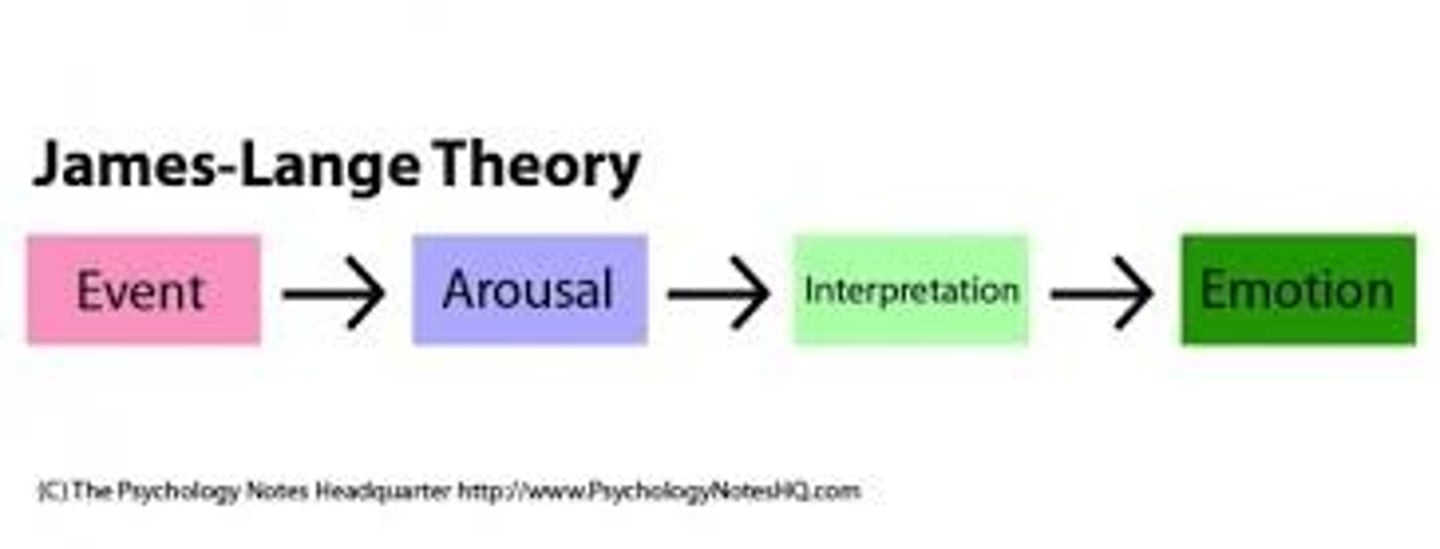
Cannon-Bard Theory
-environmental stimuli triggers
(1) physical response
(2) subjective experience of emotion
*Why it doesn't work: you can have emotion to something not there--->don't know the stimuli
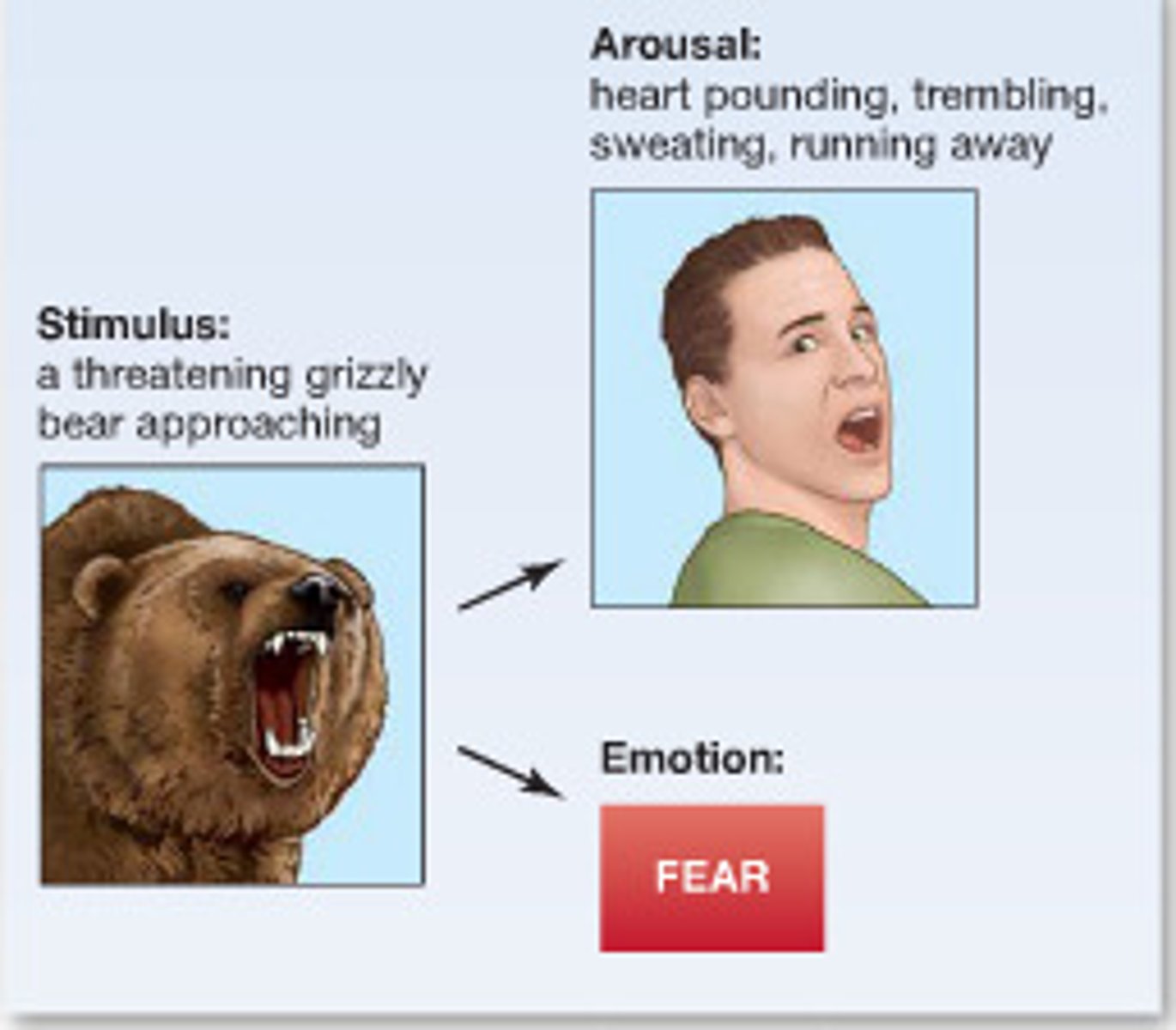
Shakhter-Singer Theory (Two Factor Theory of Emotion)
-emotion is applying a cognitive label to a physiological response (a combination of a cognitive label / physical response)
-stimulus is not needed
rope bridge study
Motivation
-from Latin word "to move"
-a motive initiates behavior & gives it a direction or a goal
-provides bridge between physiology and psychology
---> FROM THE BOOK: a need or desire that energizes and directs behavior
Maslow's Hierarchy of Needs
-pyramid of needs ranging from physiological needs to self-fulfillment (you move up pyramid as lower needs are met)
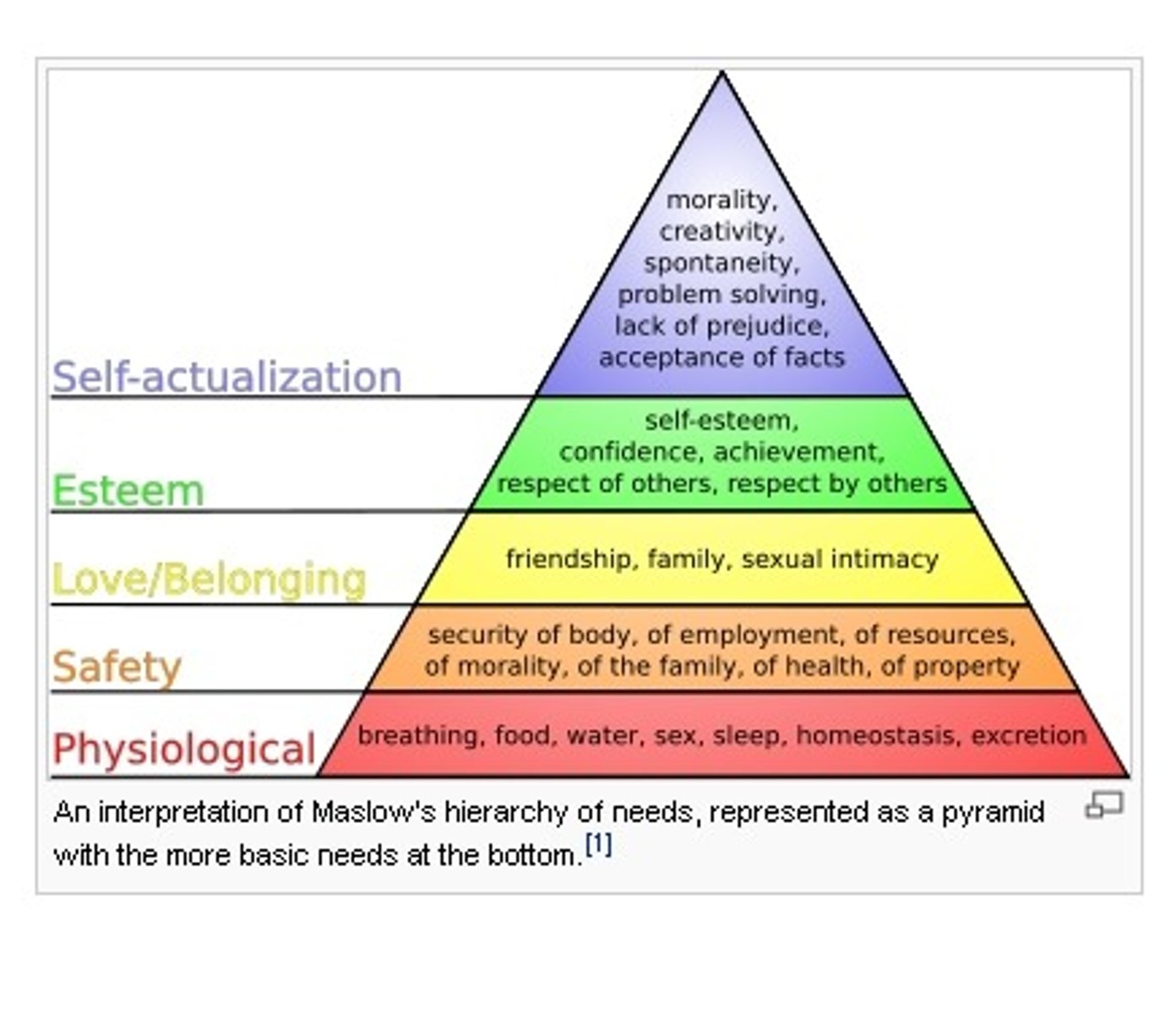
Thermoregulation
involves homeostasis & the homeostasis control process
-temperature regulation (normal human temp is around 98 degrees Fahrenheit)
-temperature = basic motive
-deviation from an internal "ideal" temperature (set point) initiates behavior:
a.) physiological behavior: sweat, blood vessels open to cool
b.) psychological/physical behavior: goose bumps = try to catch heat
Homeostasis
-our internal physiological balance of temperature, water content, & food
Homeostasis Control Process
-any system that works to actively maintain homeostatis
Thermoreceptors
-neurons that respond to temperature
Cold Rat / Hot Cat Study
-cold rat: rats in cold environment will learn to press a level to turn on eat lamp = cooling the hypothalamus leads to same psychological behavior (learn to press the lever for heat)
-hot cat: drop wire into cats brain, warm wire, and "heat" brain = cat will react as if too hot because of how body temperature interests in the hypothalamus